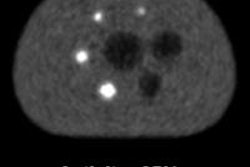Dear Molecular Imaging Insider,
This issue offers a look at the prowess of FDG-PET/CT in the diagnosis of spondylodiscitis, an inflammation of both the intervertebral disk spaces and one or more vertebrae.
MRI has been the modality of choice in this clinical application, but researchers from Barcelona Hospital Clinic say FDG-PET/CT has greater specificity and its ability to differentiate between infection of the spine and other maladies should make it the first option in suspected cases of spondylodiscitis. Read more about this study.
Radiation exposure to patients continues to be an area of deep concern. That's why you will find interesting this article on how ultrahigh-dose-rate ionizing radiation delivered in submillisecond pulses causes less damage to healthy tissue. The technique also provides comparable tumor control to that seen from the continuous irradiation used in clinical radiotherapy.
The findings from the Institut Curie in Orsay, France, have potential implications for clinical treatment approaches already using high dose rates and short irradiation times, such as scanned proton beams that deliver intensity-modulated proton therapy.
Another group of European researchers have set the groundwork for what they believe is a feasible way to achieve optimal image quality in PET/MRI scans: balancing lower radiotracer dose with prolonged PET image acquisition time to match the longer duration needed for MR image acquisition.
Researchers used a specially designed phantom and continually reduced FDG activity while simultaneously lengthening image acquisition time. Read more about the strategy in this report.
Elsewhere, evidence supporting the clinical value of PET/MRI continues to mount, as a small study from Germany has found that the hybrid modality is effective for evaluating patients with large-vessel vasculitis (LVV).
One potential benefit is the lack of radiation exposure with contrast-enhanced MRI versus contrast-enhanced CT. MRI also delineates soft tissue better than CT, promoting greater accuracy in LVV assessment.
And, researchers from one of Europe's top cancer research facilities think they have achieved a technological milestone by successfully developing a patient-specific molecular imaging phantom using a 3D printer. A group at the Royal Marsden National Health Service Foundation Trust and Institute of Cancer Research in Sutton, U.K., are optimistic the phantom can be easily reproduced and future advances in technology will allow for inexpensive manufacture of the devices using this method.
Stay in touch with the Molecular Imaging Digital Community on a daily basis to be informed on the latest news and research from Europe and around the world.




















